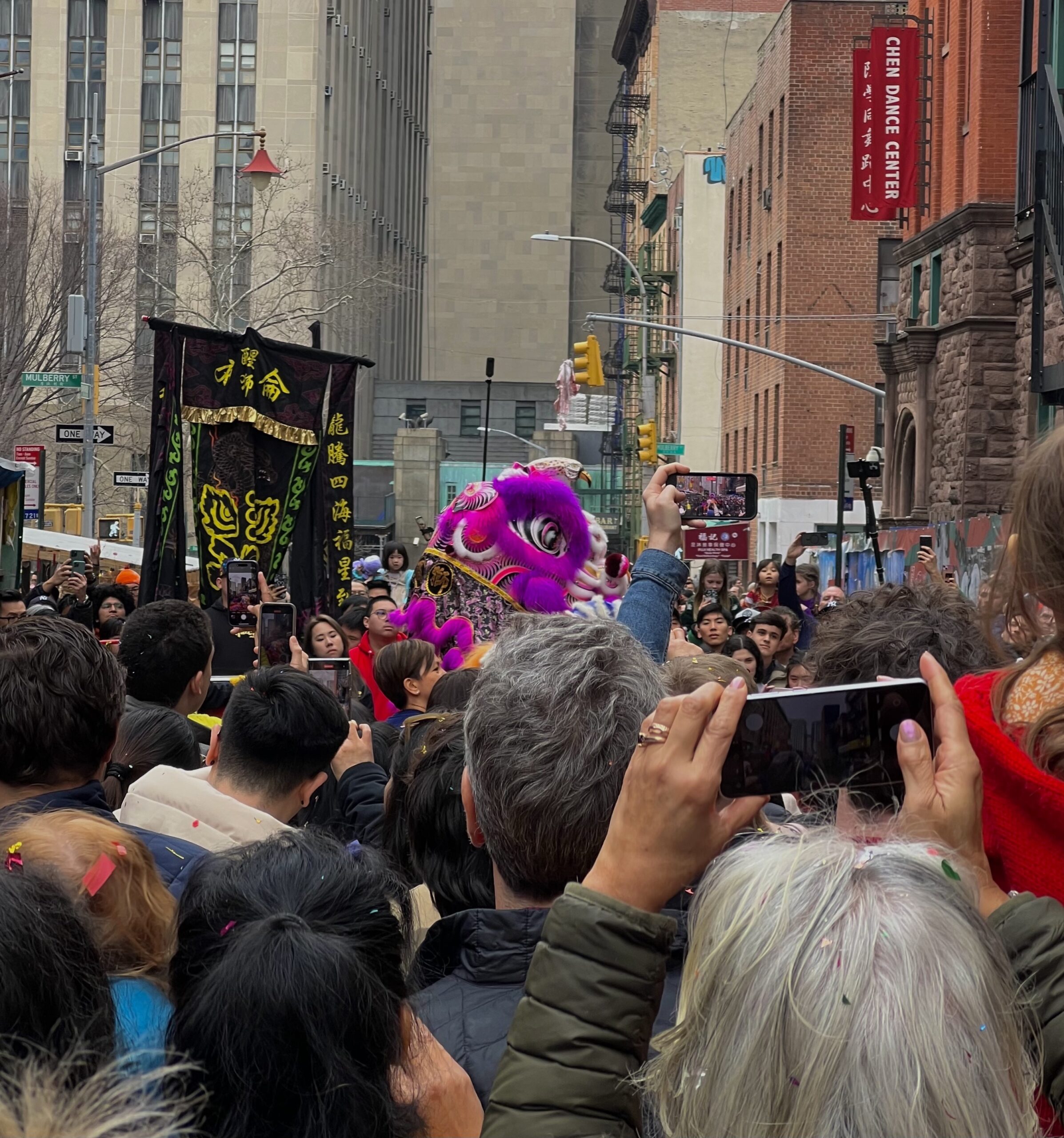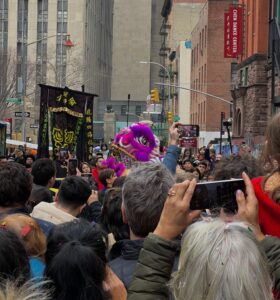
New York University sophomore Megan Nguyen lets out a delighted gasp as she locks eyes with a seven foot purple creature made up of layers of patterned fabrics, embellished with sequins and fur, bouncing its huge head up, down and side-to-side. A circle of onlookers brandish their phones and let out astonished giggles as the creature bats its large tinsel lashes at Nguyen, bending down so she can pet its intricately decorated head.
This is not an unusual sight for New York City’s Chinatown. On Feb. 10, its streets erupted with the frenzied popping of confetti cannons and firecrackers as people gathered to kick off the first day of Lunar New Year celebrations. This year is the lucky Year of the Dragon and marks Chinatown’s 26th Annual Lunar New Year Firecracker Ceremony and Cultural Festival.
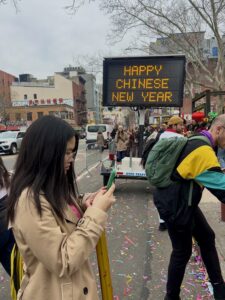
“This is actually my first time celebrating Lunar New Year in New York, and it’s already been so much fun,” Nguyen said, bright confetti strewn across her hair.
Originally from St. Louis, Missouri, Nguyen transferred to NYU last fall to study Social and Cultural Analysis, and is slowly discovering the city. Although she still needs Google Maps to get around and has yet to venture further than midtown, she says that celebrating Lunar New Year in one of the most infamous Chinatowns in the country makes her feel like a “real New Yorker.”
Back home, Nguyen would go to the Buddhist temple every Lunar New Year in her favorite pink áo dài, a traditional Vietnamese garment made up of a split tunic and flowy silk pants. Though this year she traded her áo dài for a pink sweater, many others flocked to Chinatown dressed in vibrant áo dàis and other traditional Asian dress, from pastel Chinese hanfus with long, airy sleeves, to Korean hanboks with voluminous skirts of rich reds and blues.
While everyone enjoys the festivities, rhythmic drumming thunders through the historic streets. Teenagers queue to get pork buns, Malaysian food or dimsum, and old ladies snake between the crowd cradling stacks of confetti poppers, yelling “5 dollars to celebrate the new year!” and “I’ll give you 3 for 10 dollars,” the price of each varying on every street corner.
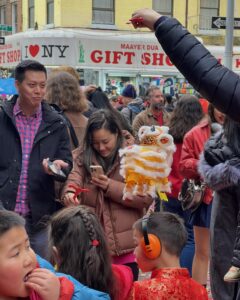
As the drumming grows louder, fathers place children on their shoulders and feet hurriedly shuffle back. It is at this point that a rainbow sea of dozens of elaborately decorated creatures with giant lion heads emerge from around the corner of Mott Street, flouncing through the crowd.
Poking out from underneath the colorful tassels and shimmering fabric of these beasts are two pairs of legs moving in step with one another. They nimbly make their way across the confetti covered street, their sneakers prancing over discarded confetti cannons and gracefully sidestepping onlookers.
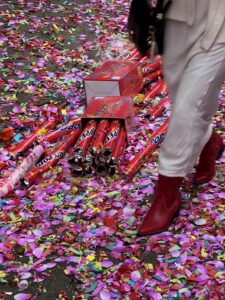
Nguyen had never seen lion dancers before, but by some stroke of luck (“probably because it’s the Year of the Dragon and all that”) she was able to come face to face with a lion.
“I kind of didn’t know what to do at first when they came up to me, but I saw others reaching out to pet their heads so I also did the same,” Nguyen said.
Underneath the playful lion head blinking down at Nguyen, two dancers are executing a series of complex motions with little to no visibility. They dance for minutes on end under the stifling hot costume, tugging at hidden strings to make the lion blink and open its mouth to the crowd.
“It’s very hot in [the costume], especially in the back since you’re just head down most of the time, but it’s really fun because you learn how to make the lion have expressions by moving the eyes, the ears and the mouth,” said Emily Wang, a sophomore at Columbia University and a member of Columbia University Lion Dance (CULD).
Lion dancing is a traditional Chinese dance that incorporates storytelling, dance and martial arts. The lion is made up of two people—one holding the head of the creature, the other holding the body—and follows the beat of a drum, which is considered to be the heartbeat of the lion.
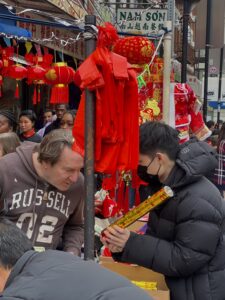
Some lion heads can be deceivingly bulky, like CULD’s yellow lion dán tá, which means custard tart. Wang hates dán tá —“he’s super heavy”—and much prefers eggplant, a purple lion that’s a bit tattered but weighs less and is more photogenic.
The interactive portion of lion dancing is what both the crowd and dancers love most about the art form, and this Lunar New Year was no different. As the lions twirled around, their tassels dancing in the wind, people waved frantically hoping to catch the eye of one of the colorful beasts—to have a lion interact with you is a sign of good luck.
“It’s really cute seeing people react to [the lions] because it’s always such a treat for them,” said Tiffany Qian, a senior at Columbia University and member of CULD. “It makes me happy to be able to do that for the community.”
Nguyen’s hand remains outstretched as the purple lion prances away, scoping out the crowd for its next target. Once it sinks away into the waves of people, Nguyen turns towards her friends, grinning from ear to ear and clapping her hands—“Oh my god, it was so cute”— before pulling out of her pocket a few crinkled dollar bills.
“Let’s get confetti poppers next!”


